Picture a charming old house with a towering chimney with a slight tilt, as if slanting to one side. While it may evoke images of whimsical tales, a leaning chimney signifies a structural issue that demands serious consideration.
Addressing this issue is crucial to counter potential hazards and maintain the safety of your home. This includes preventing loose bricks from tumbling onto unsuspecting pedestrians, protecting the integrity of your roof, and safeguarding your home against pest infiltration and water damage from leaks.
This blog post will provide you with essential information on everything you need to know about leaning chimneys. It will also guide you in dealing with such a chimney and the preventive measures to take to avoid a leaning chimney.
Causes of a Leaning Chimney
Many reasons could contribute to a chimney pulling away from the house. Therefore, identifying the underlying cause is essential in determining the appropriate action and measures to take during rectification.
That said, the following are some common causes of a leaning chimney.
Foundation Issues
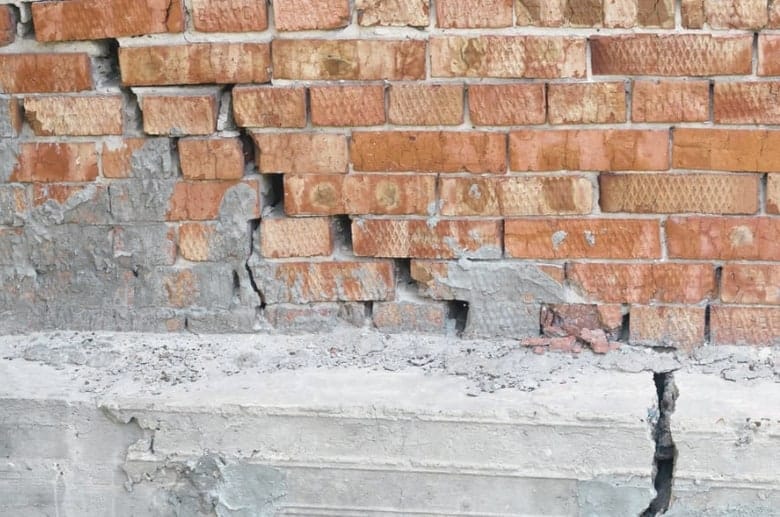
As the name suggests, foundation issues are problems or abnormalities that affect the base upon which a building or structure is constructed. Various factors can cause problems with chimney footing, but the most common ones include the following:
- Settlement: Foundation settlement is the vertical downward movement of a building’s foundation due to soil compression, consolidation, or inadequate support. When a foundation undergoes settlement, it settles unevenly. This causes structures connected to the foundation, like the chimney, to experience tilting or leaning. Eventually, this can lead to a visible slant.
- Shifting Soil: This is soil displacement beneath a building’s foundation due to expansion or contraction, leading to structural instability. When the soil shifts, it exerts pressure on the foundation, pushing it in different directions. As a result, the chimney moves away from its vertical alignment, creating a gap or causing it to lean.
- Moisture Damage: When excessive moisture infiltrates the soil, it deteriorates foundation materials like concrete, corrodes the metal reinforcements, and degrades wood. This compromises the overall strength of the foundation, causing the chimney to lean out of its normal position.
Roof Issues
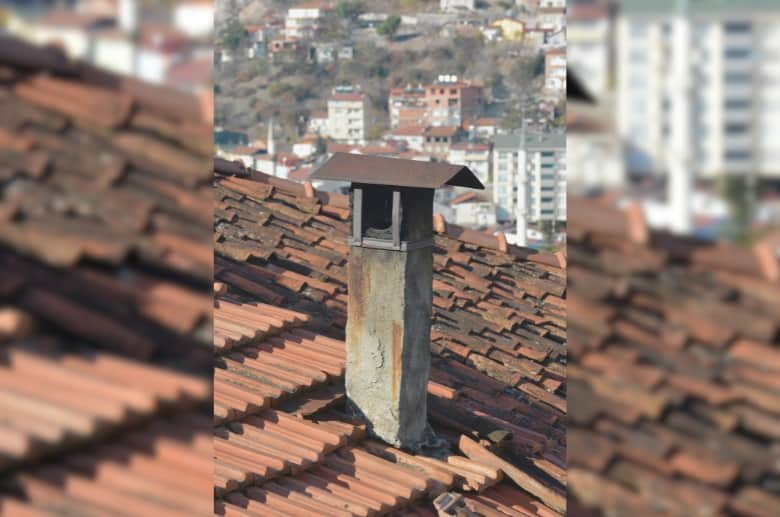
The integrity of a chimney is closely tied to the condition of the roof it is attached to. Roof issues can contribute to a leaning chimney, posing safety risks and structural concerns. Below are the most common roof-related causes of a leaning chimney:
- Excessive Weight: Excessive weight can cause the chimney to lean. But what leads to so much weight? Some factors include heavy snow or ice accumulation on the roof during winter, adding multiple layers of roofing materials without considering the load-bearing capacity, or heavy equipment or debris on the roof. The excessive weight places undue stress on the roof structure, including the chimney, leading to an imbalance that causes the chimney to lean or tilt.
- Storm Damage: High winds can exert intense pressure on the roof, potentially dislodging or loosening roofing materials and compromising the integrity of flashing during storms. This weakens the roof’s structure, leading to an unstable support system for the chimney, causing it to lean.
- Poor Construction: An improperly designed or poorly constructed roof can contribute to a leaning chimney over time due to issues like improper installation of flashing, use of substandard materials, or insufficient ventilation. This can compromise the stability of the roof structure and result in sagging, which in turn affects the alignment of the chimney.
——
Do You Need to Hire Chimney & Fireplace Expert?
Get free quotes from qualified experts near you. No commitment required!
——
Signs of a Chimney Separating From House
If your chimney separates from your house, you have a serious structural issue requiring immediate attention. Ignoring the signs of this problem can lead to further damage and safety hazards.
Let’s look at the common signs that indicate your chimney is separating from the house.
1. Visible Tilting or Leaning
This is the most obvious sign that you might have a chimney separating from your house. At first, it might be challenging to notice in its early stages without careful inspection and use of tools.
However, as time passes, the tilting or leaning becomes more pronounced and noticeable even to the naked eye.
2. Cracks in Masonry
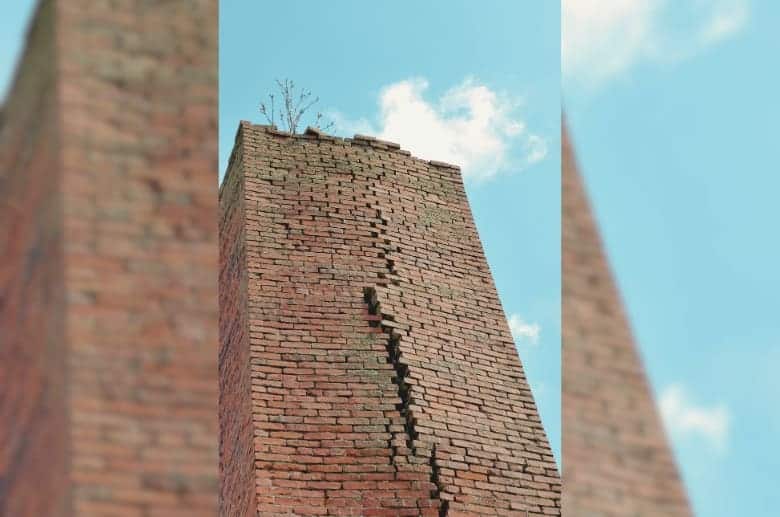
Cracks in masonry are another common indication of a chimney separating from the house due to the shifting and movement of the structure. As the chimney separates from the house, the forces acting upon it create tension and compression within the masonry.
Over time, these forces can exceed the structural capacity of the masonry, resulting in visible cracks. These cracks appear in the mortar joints or the bricks or stones themselves.
3. Loose Bricks or Stones
When a chimney begins to separate from the house, it loosens or dislodges bricks or stones. This shift creates spaces between the bricks and the stones, weakening the connections between the masonry units and the mortar.
You may notice loose bricks or stones outside the chimney or fallen pieces inside the house.
4. Water Leaks
When a chimney separates, it creates gaps or openings between the chimney and the house, allowing water to infiltrate. This results in water leaks manifesting as stains or water damage on the interior walls or ceilings near the chimney.
In some cases, leaks may be evident in the attic space or the house’s exterior near the chimney.
Risks Of Tilting Chimney
A tilting chimney poses risks and hazards that should not be overlooked.
Structural Damage to the House
A chimney weighs thousands of pounds. And if it comes crashing down or experiences significant tilting, it can result in severe structural damage to your home.
The weight and force of a falling or leaning chimney can cause extensive destruction to the roof, walls, and foundation.
Fire Hazards

A leaning or a tilting chimney creates gaps and openings between the chimney and the surrounding structure. These gaps allow hot gases, sparks, or embers to escape from the chimney and come into contact with combustible materials in or around the house.
Additionally, gaps or openings in a tilting chimney disrupt the proper draft and airflow. This leads to inadequate ventilation and inefficient combustion, causing the accumulation of flammable materials like creosote inside the chimney, which can lead to a fire breakout.
Health Hazards
Suppose you have a leaning chimney in your home. In that case, it’s most likely to compromise the proper functioning of your chimney flue, leading to the infiltration of harmful gasses like carbon monoxide, smoke, and pollutants into the living spaces of your house.
Financial Losses
Structural issues caused by a leaning chimney can result in costly repairs and restoration work, significantly decreasing your home value and impacting your finances. Depending on the severity of the issue, it may involve reinforcing the foundation, repairing or rebuilding the chimney, or even making structural modifications to the house.
In addition, addressing these issues requires professional intervention, which can incur significant costs.
——
Do You Need to Hire Chimney & Fireplace Expert?
Get free quotes from qualified experts near you. No commitment required!
——
Leaning Chimney Repair & Preventions
When faced with a leaning chimney, it’s crucial to address the issue promptly to prevent further damage and ensure the safety and stability of your home. Below, we’ll discuss various repair options and preventative steps to mitigate the risks of a leaning chimney.
Inspection and Assessment
This is the first step toward leaning chimney repair, and it involves thoroughly examining the chimney to understand the extent of the leaning and identifying the underlying causes.
In this step, we recommend contacting a professional chimney specialist or structural engineer for the inspection. The expert will provide valuable information to determine the appropriate repair methods and effective plans tailored to your situation.
Repair Options
When it comes to repairing a leaning chimney, several options are available depending on the severity of the issue. However, there are three commonly used repair options:
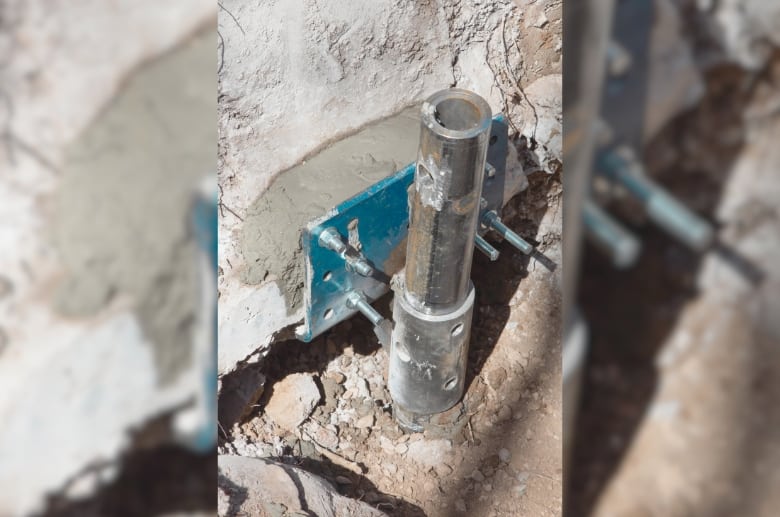
- Underpinning: This option involves reinforcing the chimney’s foundation to provide additional support and stability. This can be achieved through helical piers or push piers driven deep into the ground beneath the foundation. The piers transfer the weight of the chimney to more stable soil layers, preventing further movement and tilting.
- Stabilization: Stabilization techniques focus on strengthening the existing structure of the chimney to prevent further tilting. This can be done by installing steel braces or anchors that connect the chimney to the house’s structure. These elements provide lateral support, minimizing the risk of further movement and maintaining the stability of the chimney.
- Rebuilding: If the damage to the chimney is severe or irreversible, demolishing the existing chimney may be necessary; then, you could construct a new one. Rebuilding allows for a fresh start, ensuring the new chimney is structurally sound and aligned. It may also be an opportunity to incorporate design improvements or upgrade the chimney’s materials for enhanced durability.
How Do I Prevent My Chimney From Leaning in the Future?
Taking preventive measures is crucial to prevent your chimney from leaning in the future. These measures can ensure the stability and longevity of your chimney:
1. Regular Maintenance and Cleaning
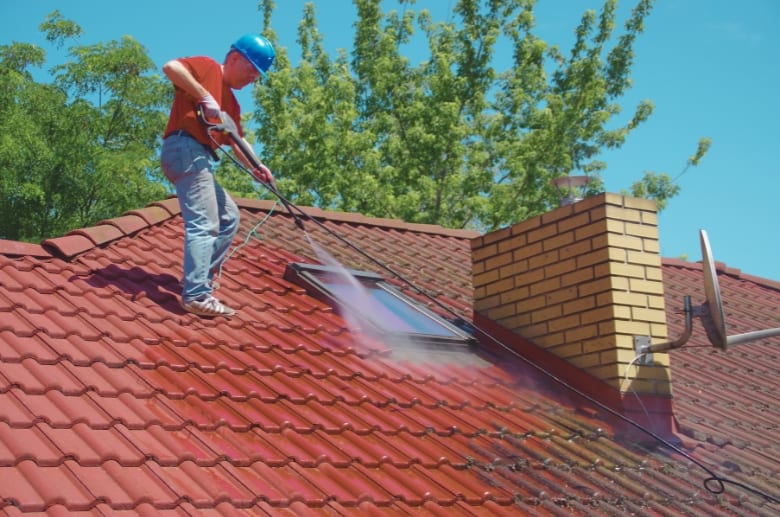
We recommend implementing an annual routine maintenance schedule to detect and address potential issues that may cause a leaning chimney before they escalate.
This involves scheduling annual inspections by professional chimney sweeps, who will help you check for signs of damage, deterioration, or structural issues that could contribute to leaning.
The chimney professional will also help you clean and remove creosote buildup, debris, and blockages that can hinder proper ventilation and pose fire hazards.
2. Proper Roof Drainage
Ensure that your roof has proper drainage systems in place. Clogged gutters or downspouts can cause water to accumulate around your chimney’s foundation, leading to moisture damage and potential foundation issues.
Regularly clean and maintain your gutters and ensure they direct water away from the foundation.
3. Corrective Landscaping
Pay attention to the landscaping around your chimney. Ensure the soil is properly graded to slope away from the foundation, directing water away from the chimney. Avoid planting trees or shrubs too close to the chimney, as their roots can potentially disturb the foundation.
Also, avoid excessive watering near the chimney to prevent soil erosion and moisture buildup.
4. Professional Consultation
Engage the expertise of a qualified chimney professional or structural engineer to ensure the structural strength of your chimney is assessed regularly. These experts will conduct thorough inspections to identify underlying issues that may compromise the stability of your chimney.
And if any issues are found, they will provide a tailored solution based on the specific circumstances early on.
——
Do You Need to Hire Chimney & Fireplace Expert?
Get free quotes from qualified experts near you. No commitment required!
——
Hiring a Professional for Chimney Repair
Hiring a professional is the best option when faced with chimney repair needs. Their expertise ensures proper and safe repairs, addressing specific issues while providing peace of mind. Here are some of the top reasons you’d want to hire professional services for any chimney problems:
- Expertise and Knowledge: Certified professionals have undergone training and can handle chimney repairs effectively.
- Skill and Experience: Experts have practical experience repairing chimneys and are familiar with various chimney systems, materials, and construction methods.
- Adherence to Standards: Professionals are required to follow industry standards and codes of practice, ensuring that repairs are carried out to the highest quality and safety standards.
- Proper Diagnosis: Certified chimney sweeps can accurately diagnose the underlying issues causing the chimney problem and recommend appropriate solutions.
- Long-Term Solutions: A certified chimney sweep will provide lasting and durable repairs that address the root cause of the issue. This minimizes the likelihood of future problems and the need for further repairs.
How Much Does It Cost to Repair a Leaning Chimney?
It will cost you an average of $1,200 to $4,500 to repair your leaning chimney. However, the cost will vary depending on various factors, like the severity of the lean, required materials, chimney access, height, and labor costs.
Does Homeowners Insurance Cover Leaning Chimney Repair Costs?
It might be challenging for homeowners’ insurance policies to cover leaning chimneys unless the leaning results from a sudden and unexpected event, such as a natural disaster.
Insurance coverage typically applies to sudden and accidental damage rather than gradual wear and tear or maintenance issues.
Questions to Ask Before Hiring a Chimney Repair Professional
Now that it’s certain that you need a professional for the job, it’s essential that you hire the right chimney sweep to fix the damage. Below are some questions to ask before hiring a chimney repair professional:
1. Are you licensed and insured? It’s vital to ensure the professional holds the necessary licenses and carries liability insurance to protect against any potential accidents or damages during the repair process.
2. What experience do you have with chimney repairs? Inquire about the professional’s experience in chimney repairs, including the number of years in the industry and the types of repairs they have completed successfully.
3. Can you provide references or customer testimonials? Request references or testimonials from previous clients to gain insight into the professional’s reputation, quality of work, and customer satisfaction.
Conclusion
A leaning chimney can pose serious structural issues and requires prompt attention to ensure the safety and stability of your home. Seeking professional consultation, including a chimney inspection and assistance from roofing contractors, is a crucial preventive measure when dealing with a leaning chimney.
This is because a certified professional will assess the situation, identify the cause, and provide tailored solutions to address the problem effectively.
In addition, taking preventive measures for your chimney’s maintenance is always advised. If you suspect a leaning chimney, it is crucial to take action and seek professional consultation to assess the situation and implement necessary repairs.






